The traditional perfume blending ratio follows a 30:50:20 (top:middle:base) structure, but you can adjust this based on your desired effect. For a balanced fragrance, try a 1:1:1 ratio, or use 3:2:1 to highlight brighter top notes. You'll need to take into account seasonal adjustments too – summer blends work well with 40:40:20, while winter scents benefit from 20:30:50. Understanding these foundational ratios will open the door to creating your own signature scent combinations.
Understanding Basic Fragrance Note Categories
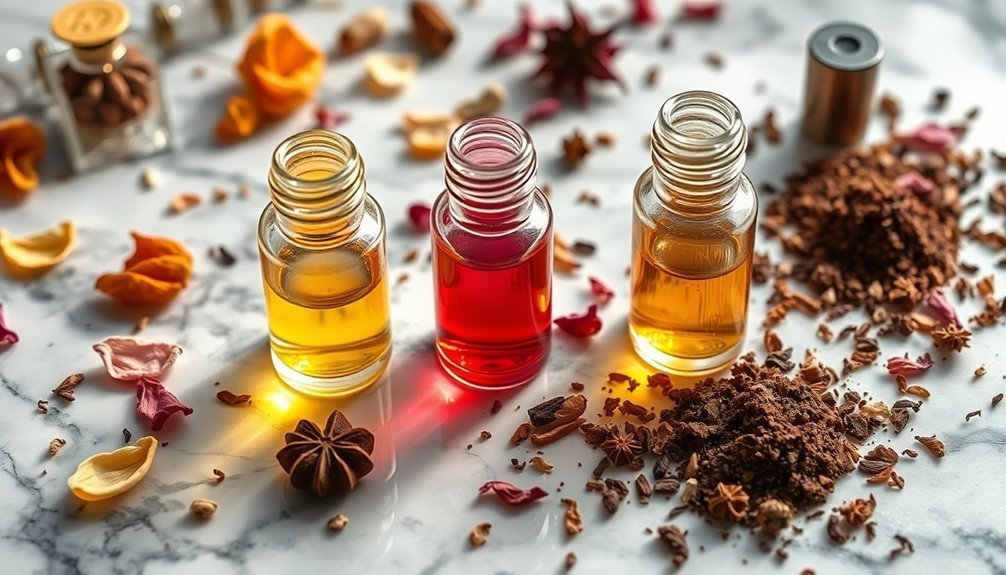
When creating custom fragrances, you'll need to master the three main fragrance note categories: top, heart, and base notes.
The top notes create your first impression, featuring light, fresh scents like citrus and lavender that last 5-15 minutes. These volatile notes shift into the heart notes, which form the core of your fragrance.
Heart notes dominate for several hours, making up about 70% of the total scent with floral, spicy, and herbal elements like jasmine and cinnamon. They bridge the gap between top and base notes.
Your base notes provide lasting power, sometimes persisting for days. These deep, warm scents include woody and musky ingredients like sandalwood and patchouli. While they take longer to emerge, they're essential for anchoring your fragrance and warming up the lighter notes. Base notes typically require about 30 minutes to activate and continue to develop throughout wear.
Traditional Perfume Blending Ratios Explained
You'll find that traditional perfume blending follows a classic three-layer structure of top, middle, and base notes in a 30:50:20 ratio respectively.
When you mix your fragrances in this proportion, you're creating a time-release effect where each note reveals itself at different stages. Using a clean pipette for each oil ensures precise measurements and prevents cross-contamination.
Your top notes will make the initial impression, followed by middle notes that emerge after 10-30 minutes, while base notes ground the entire composition and last the longest.
Classic Three-Layer Structure
The classic three-layer structure of perfumery forms the foundation of modern fragrance creation, built on Jean Carles' revolutionary fragrance pyramid concept.
In this structure, you'll find three distinct layers that work together harmoniously. The top notes hit your senses first with light, fresh scents that quickly evaporate, setting the tone for your fragrance. As these fade, the middle notes emerge, providing the fragrance's main character through floral, spicy, or fruity elements. These heart notes typically make up 65-70% of fragrance composition, creating the perfume's core identity.
Finally, the base notes create a rich foundation that lingers longest on your skin.
While traditional ratios like "3,2,1" exist, you're not bound by strict rules. Instead, you can adjust the proportions based on your desired effect, whether you want immediate impact with stronger top notes or lasting power with dominant base notes.
Ratio Time Release Effect
Understanding ratio time release effects builds directly on the three-layer structure concept. When you blend fragrances, each concentration level creates a distinct time-release pattern that affects how long your scent will last.
| Concentration | Release Pattern | Duration |
|---|---|---|
| Perfume (15-30%) | Sustained | 6-8 hours |
| EDP (8-15%) | Gradual | 4-6 hours |
| EDT (4-8%) | Quick | 2-4 hours |
You'll notice that higher concentrations create longer-lasting scents through controlled release mechanisms. Perfumes use membrane technology to achieve this sustained release, while eau de toilettes deliver a quick burst of fragrance. The thickness of these permeable membranes directly impacts how your fragrance unfolds over time – thinner ones give you that immediate impact, while thicker ones guarantee your scent lingers throughout the day.
The Science Behind Top, Middle, and Base Notes

The molecular weight of fragrance ingredients directly determines whether they'll function as top, middle, or base notes in your perfume composition.
You'll notice that lighter molecules evaporate quickly as top notes while heavier ones linger as base notes, creating a time-released progression of scent.
The chemical bonding between different molecular structures helps you achieve a harmonious blend where each note shifts smoothly into the next.
Molecular Weight Determines Notes
Deep within the science of perfumery, molecular weight plays a decisive role in determining how fragrances evolve on your skin.
You'll notice that lighter molecules evaporate quickly, while heavier ones linger longer, creating the distinct layers of a fragrance's progression.
Understanding molecular weight helps you predict how your fragrance will perform:
- Top notes contain light, volatile molecules like those found in citrus oils, giving you an immediate but fleeting burst of scent.
- Middle notes feature moderate-weight molecules like linalool in lavender, lasting 20-60 minutes on your skin.
- Base notes use heavy molecules found in woods and vanilla, providing a lasting foundation.
- The heavier the molecule, the longer it'll stay on your skin, which is why base notes can last several hours.
Evaporation Rate Affects Duration
When you smell a fragrance, you're experiencing a carefully orchestrated dance of evaporating molecules that unfold over time. The evaporation rate of each note determines how long it'll linger on your skin.
Top notes evaporate quickly, giving you that initial burst of citrus or herbs that lasts just a few minutes. As these fade, middle notes emerge, typically featuring floral or spicy scents that persist for up to an hour.
These heart notes form the fragrance's core character while bridging to the base notes. Base notes, like musk and sandalwood, are the least volatile. They'll stay with you for hours, acting as fixatives that slow down the evaporation of other notes.
To create a balanced fragrance, perfumers must carefully consider these varying evaporation rates, often using specific ratios like 1:1:1 or 4:2:1.
Bonding Creates Scent Harmony
Creating harmonious fragrances requires understanding how different scent molecules bond and interact with each other. When you blend fragrances, you'll notice how top, middle, and base notes work together through their molecular bonding properties.
The volatility of each note determines its evaporation rate and how it mingles with other scents to create a complex olfactory experience.
- Top notes (20-40% of blend) create initial impact through light, volatile molecules like citrus.
- Middle notes (50-75% of blend) bridge the gap with balanced molecules like florals and herbs.
- Base notes (5-10% of blend) provide foundation through heavy molecules like woods and musks.
- Drop-by-drop blending helps you fine-tune these molecular interactions for ideal scent harmony.
Each layer bonds with the others, creating a seamless shift as the fragrance develops on your skin.
Essential Ratios for Beginner Perfumers
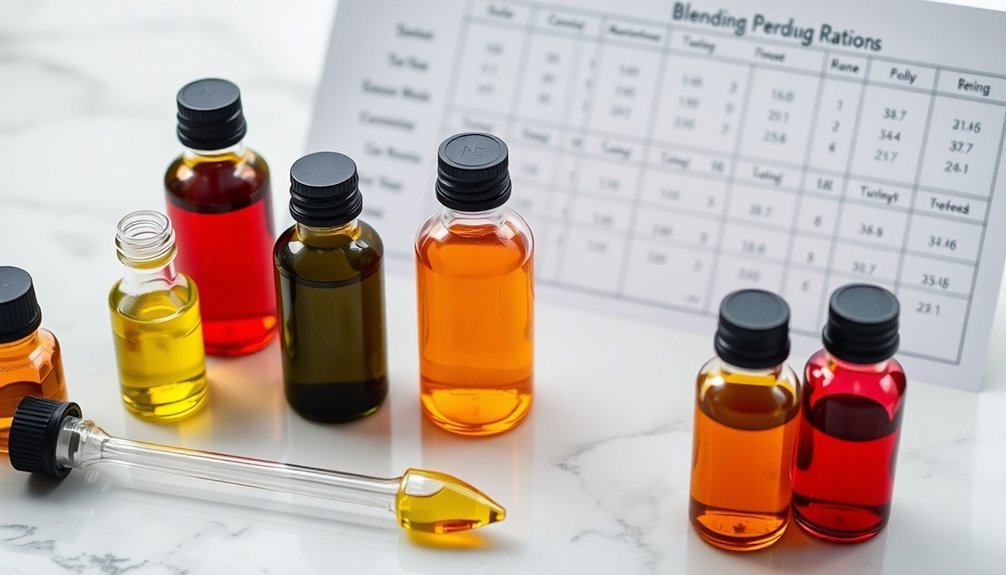
Three fundamental ratios form the backbone of perfumery for beginners. The most widely used is the 30/50/20 rule, where you'll combine 30% top notes, 50% middle notes, and 20% base notes.
For a simple 10-drop blend, that's 3 drops top, 5 drops middle, and 2 drops base.
You can also explore two alternative ratios: the balanced 1:1:1 approach, which gives equal weight to each note category, or the dynamic 3:2:1 ratio that emphasizes brighter top notes.
When crafting your blend, you're free to use multiple oils within each note category while maintaining these proportions. For instance, you might split your top notes between lemon and spearmint, keeping the total ratio intact.
Advanced Blending Techniques for Complex Scents
Beyond basic ratios, advanced fragrance blending opens up a world of intricate possibilities. You'll need to master the art of layering scents and understanding how different notes interact over time.
Start by blending your base notes first, then gradually incorporate middle and top notes while keeping detailed records of each drop added.
- Create small test batches and let them mature for at least a week to evaluate how the scents develop and interact.
- Experiment with complementary scent categories, such as pairing woodsy with spicy or floral with citrus notes.
- Use the drop-by-drop technique to fine-tune your ratios until you achieve the perfect harmony.
- Consider seasonal factors and adjust your blends accordingly, using warmer notes for winter and lighter ones for summer.
Customizing Ratios for Different Fragrance Families
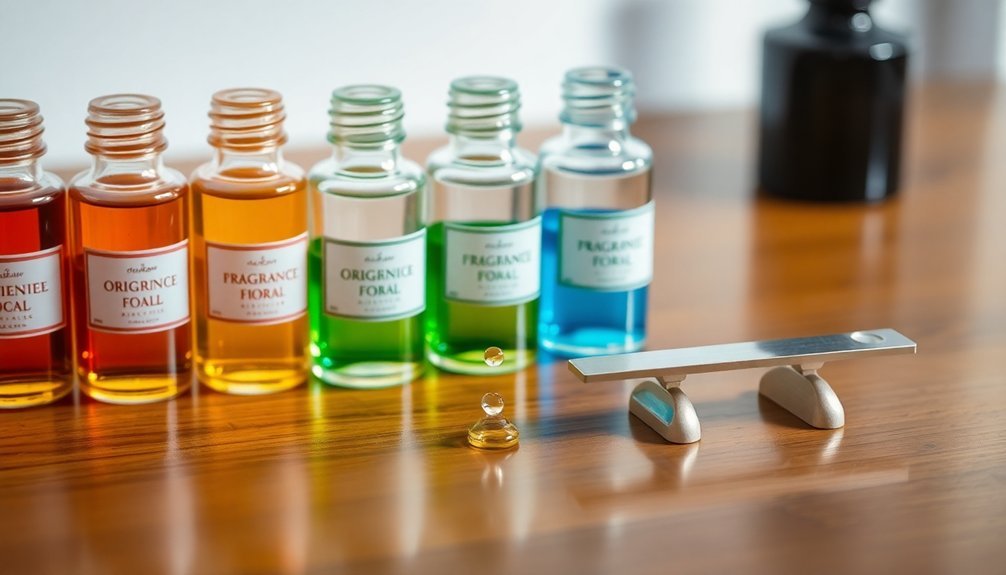
When crafting your perfect fragrance blend, understanding the distinct ratios for different fragrance families is essential to achieving professional results. Each family requires specific proportions to maintain balance and harmony in your final creation.
| Fragrance Family | Recommended Ratio |
|---|---|
| Woody | 3:1 with citrus |
| Floral | 1:1 or 2:3 blend |
| Amber | 5:2 with vanilla |
You'll find that woody fragrances can handle more flexible ratios due to their grounding nature, while florals need precise measurements to avoid overwhelming the blend. When working with amber notes, use higher proportions to capitalize on their warmth, and keep fresh citrus notes in lighter ratios to maintain their bright character. Remember to adjust your batch sizes while maintaining these core ratios for consistent results.
Common Mistakes in Fragrance Blending
Even with the perfect ratios in hand, perfumers can stumble into common pitfalls that compromise their fragrance creations. Understanding these mistakes will help you create better blends and achieve the desired results in your perfumery journey.
- Don't let your scent strips cross paths or touch each other during the blending process – this creates unwanted scent cocktails that muddle your evaluation. Keep them separated using a notebook.
- Avoid rubbing your wrists after applying fragrances, as the heat breaks down top notes and alters the intended scent profile. Let them air dry naturally.
- Consider your environment and occasion when creating blends. Heavy scents don't work well in summer, while light florals might disappear in evening settings.
- Never neglect skin moisture – dry skin makes fragrances fade quickly. Apply moisturizer before testing your blends to guarantee proper longevity.
Measuring and Recording Your Blends
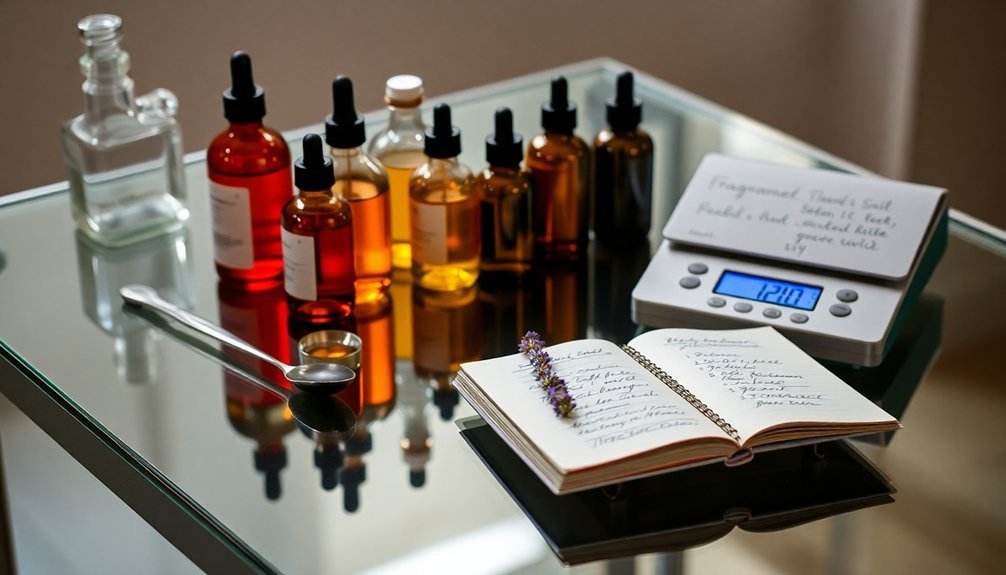
Precise measurement and thorough documentation form the foundation of successful fragrance blending.
You'll need a digital scale with 0.01g precision, glass beakers, pipettes, and proper storage bottles to guarantee accuracy in your measurements.
When measuring your fragrances, start by setting your scale to the desired unit and using the tare function to zero out your container weight.
Calculate your fragrance load as a percentage of the total wax weight – for instance, if you're making a 16 oz candle with an 8% load, you'll need 1.28 oz of fragrance oil.
Don't forget to record every detail of your blends.
Use a notebook or digital spreadsheet to track your measurements, client feedback, and formula calculations.
Label all your blends clearly and maintain organized documentation for future reference and replication.
Adjusting Ratios for Seasonal Fragrances
When crafting seasonal fragrances, you'll need to adjust your blending ratios to match the mood of each season, with summer blends favoring light citrus and floral top notes while winter compositions lean toward heavier spice and wood base notes.
Your summer fragrances should follow a ratio emphasizing top notes (40/40/20) to create bright, invigorating scents, while winter blends work better with a base-heavy ratio (20/30/50) for warmth and depth.
The selection of seasonal ingredients plays an essential role in your ratios, as lighter materials like bergamot and sweet orange naturally complement summer blends, while rich elements like cinnamon and frankincense enhance winter formulations.
Summer Vs Winter Blends
Seasonal changes greatly influence how fragrances are blended, with summer and winter requiring distinct ratio adjustments to achieve the ideal scent.
You'll notice summer fragrances lean towards lighter, fresher combinations, while winter blends embrace warmer, deeper notes.
For optimal seasonal blending, follow these key differences:
- Top notes shift from 20-30% in summer (citrus, mint) to 10-20% in winter (spices, cloves)
- Middle notes increase from 30-40% in summer (light florals) to 40-50% in winter (rich florals, spices)
- Base notes adjust from 40-50% in summer (light woods, vanilla) to 50-60% in winter (amber, musk)
- Summer blends prioritize freshness with fruits and light florals, while winter blends focus on warmth through spices and rich woods.
Light Vs Heavy Notes
Understanding the delicate balance between light and heavy notes is essential for creating seasonally appropriate fragrances. When you're working with light notes like citrus and florals, aim for 30% of your blend to maintain a fresh, uplifting aroma without overwhelming the composition.
These notes evaporate quickly, so they'll need more frequent adjustments.
Heavy base notes, such as woody and earthy scents, should make up only 20% of your blend due to their powerful nature and long-lasting properties. You'll want to start with fewer drops of these notes, like using just 3 drops of Vetiver in a 20-drop blend.
To achieve balance, pair your heavy notes with light top notes, and use middle notes as binders to create a well-rounded fragrance that evolves smoothly through its phases.
Seasonal Ingredient Selection
Building on the principles of light and heavy notes, mastering seasonal fragrance ratios lets you create scents that resonate with each time of year.
You'll want to adjust your blending approach based on the season's character. Summer calls for higher percentages of bright top notes, while winter benefits from increased base notes for warmth and depth.
- For summer blends, use 30% top notes (citrus, mint), 50% middle notes, and 20% base notes to achieve that light, breezy feel.
- Winter fragrances work best with 20% top notes, 50% middle notes, and 30% base notes for added warmth.
- Spring blends maintain balance but lean slightly toward middle notes, featuring florals and fresh herbs.
- Keep your fragrance-to-wax ratio between 6-10% across all seasons for ideal scent throw.
Tools and Equipment for Precise Blending
Professional perfumers' workbenches come alive with an array of specialized tools designed for precise fragrance blending. You'll need essential measurement tools like digital scales and glass beakers to guarantee accuracy in your formulations. For sampling and testing, fragrance blotters and pipettes become your daily companions.
| Tool Category | Basic Equipment | Advanced Options |
|---|---|---|
| Measurement | Digital Scales | Perfume Mixing Tank |
| Transfer | Glass Pipettes | Diaphragm Pump |
| Storage | Glass Beakers | Filtration System |
| Testing | Blotting Strips | Control Panels |
For professional-grade blending, you'll want to invest in advanced machinery like a perfume mixing tank with temperature control and a proper filtration system. Don't forget the smaller but essential items: labels for tracking your blends, stirring rods for mixing, and multiple droppers for precise component addition.
Testing and Evaluating Your Fragrance Blends
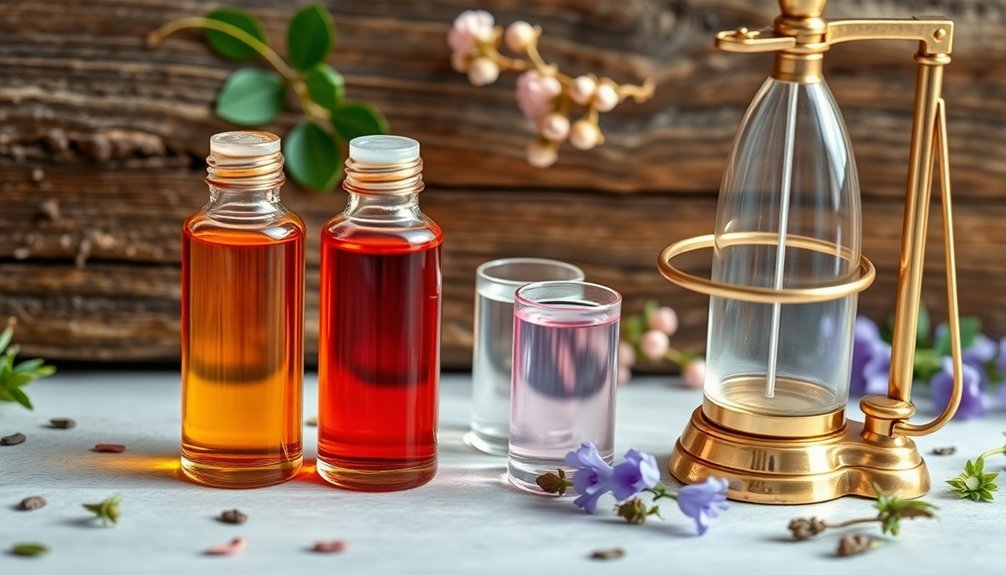
Once you've gathered your blending tools, the next step is to master fragrance evaluation techniques.
You'll need to assess your blends systematically using smelling strips, wax melts, and alternative testing methods. Start by dipping clean strips into your fragrance oils and waving them gently to let the initial notes evaporate. Create small wax melt samples to test how your blends perform in different applications.
- Test your fragrances using smelling strips first, keeping the strip a few inches from your nose
- Make 50-gram wax melt samples with 6-10% fragrance concentration
- Try alternative methods like reed diffusers or room sprays to evaluate scent throw
- Allow your test samples to cure for 10-14 days before final assessment
Remember to label all samples clearly and maintain consistent testing conditions for accurate comparisons.
Achieving Balance in Natural Perfumery
To create harmonious natural perfumes, you'll need to master the art of balancing fragrance notes in precise ratios. Start with the beginner's formula of 30% top notes, 50% middle notes, and 20% base notes. This provides a solid foundation, though you can experiment with alternative ratios like 1:1:1 or 3:2:1 as you gain confidence.
When blending, work from base notes upward, adding oils drop by drop while recording each addition. Let your blend mature for several days to allow the chemical interactions to develop fully.
Use scent strips to evaluate individual oils and their combinations before committing to larger batches. If you're working with a 5ml bottle, try starting with 10 drops base, 5 drops heart, and 5 drops head notes, then dilute with 80 drops of carrier oil.
Professional Tips for Long-Lasting Scents

Creating beautiful fragrance blends is only half the battle – making them last requires specific techniques and knowledge.
To maximize your perfume's longevity, you'll need to master both application methods and proper storage techniques. The key is understanding how fragrance molecules interact with your skin and environment.
- Apply your perfume to damp skin or use unscented body oil on pulse points – this creates a barrier that helps trap the scent molecules.
- Store your fragrances in cool, dark places away from sunlight and temperature fluctuations to maintain their potency.
- Choose perfumes with higher concentrations (EDP or Parfum) and lasting base notes like amber, vanilla, or musk.
- Layer your scents using matching shower gels and lotions, and consider using fragrance-infused jewelry for continuous release throughout the day.
Frequently Asked Questions
How Long Should I Let My Fragrance Blend Mature Before Testing?
You'll want to let your fragrance blend mature for at least 24-48 hours before initial testing. For ideal results, allow it to sit undisturbed for a week, stored in a dark bottle at room temperature.
Can Temperature and Humidity Affect My Fragrance Blending Ratios?
Yes, temperature and humidity greatly affect your blending ratios. You'll need to adjust your formulas as heat increases evaporation of top notes, while humidity can extend longevity and alter how fragrances project on skin.
What's the Shelf Life of a Custom-Blended Fragrance?
Your custom-blended fragrance typically lasts 1-3 years if stored properly. You'll get the best shelf life by keeping it in a dark, airtight container away from heat and humidity.
Are Blending Ratios Different for Synthetic Versus Natural Fragrances?
You'll use the same basic 30-50-20 ratio for both synthetic and natural fragrances, but you'll need to adjust dilution rates since natural ingredients are often more potent than their synthetic counterparts.
How Do Skin Chemistry Variations Impact Fragrance Blending Decisions?
Your skin type and pH directly affect how fragrances develop. You'll need to adjust your blending ratios – use stronger concentrations for dry skin and lighter ones for oily skin to achieve balanced results.
In Summary
Now that you've learned the art of fragrance blending, you'll find there's no truly "perfect" ratio. While the classic 30-50-20 (top-middle-base) ratio serves as a reliable starting point, don't be afraid to experiment. Trust your nose, keep detailed notes of your blends, and remember that perfumery is both science and art. With practice and patience, you'll develop your signature style and create scents that reflect your unique vision.





Leave a Reply